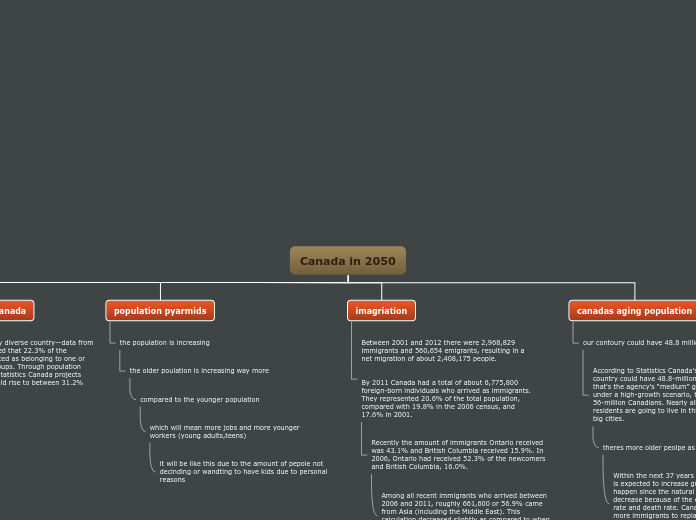Canada in 2050
changing faces in canada
Canada is an increasingly diverse country—data from the 2016 Census indicated that 22.3% of the population were designated as belonging to one or more visible minority groups. Through population projections from 2017, Statistics Canada projects that this percentage would rise to between 31.2% and 35.9% by 2036.
Subtopic
Subtopic
population pyarmids
the population is increasing
the older poulation is increasing way more
compared to the younger population
which will mean more jobs and more younger workers (young adults,teens)
it will be like this due to the amount of pepole not decinding or wandting to have kids due to personal reasons
imagriation
Between 2001 and 2012 there were 2,968,829 immigrants and 560,654 emigrants, resulting in a net migration of about 2,408,175 people.
By 2011 Canada had a total of about 6,775,800 foreign-born individuals who arrived as immigrants. They represented 20.6% of the total population, compared with 19.8% in the 2006 census, and 17.6% in 2001.
Recently the amount of immigrants Ontario received was 43.1% and British Columbia received 15.9%. In 2006, Ontario had received 52.3% of the newcomers and British Columbia, 16.0%.
Among all recent immigrants who arrived between 2006 and 2011, roughly 661,600 or 56.9% came from Asia (including the Middle East). This calculation decreased slightly as compared to when 60.0% of people from Asia arrived between 2001 and 2005.
canadas aging population
our contoury could have 48.8 million pepole by 2050
According to Statistics Canada's projections, our country could have 48.8-million people by 2050. And that's the agency's “medium” growth projection; under a high-growth scenario, there could soon be 56-million Canadians. Nearly all of these future residents are going to live in this country's handful of big cities.
theres more older peolpe as the yaers go on
Within the next 37 years Canada's immigration rate is expected to increase greatly. This is predicted to happen since the natural increase rate is likely to decrease because of the expected decline in the birth rate and death rate. Canada will need to welcome more immigrants to replace the baby boomers. By doing so the population and economy will continue to grow.
